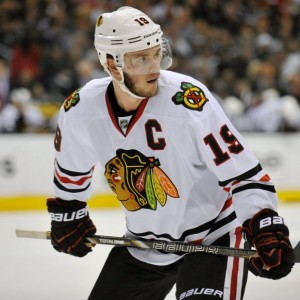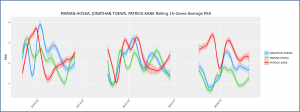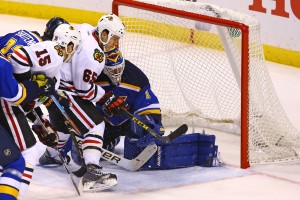The 2015-16 season probably didn’t go exactly how Marian Hossa was expecting it to. The veteran sniper and likely Hall-of-Famer scored just 33 points in his 64 games – which stands as his lowest offensive output in a full season since his rookie year. He returned to dominate in the playoffs on a makeshift third line with Andrew Ladd and Marcus Kruger, but his regular season decline still stands.
Hossa will be 37 when the 2016-17 season kicks off, and expecting him to return to his 30-goal and 70-point days seems somewhat far-fetched given the dramatic 29-point drop-off he experienced from 2014 to 2015. So while a rebound of sorts could very well be in the cards, counting on a full return to glory for Hossa would just be flat-out unreasonable.

So if Hossa’s natural decline due to age doesn’t seem to be stopping anytime soon, the next question becomes how that change in performance will affect the rest of the Blackhawks lineup, notably Jonathan Toews.
Star Impact
Hossa and Toews have been regulars on Chicago’s top line for the past three seasons, and each player has thrived for the majority of their time playing together. The power, skill, and incredible defense that each player possesses means that the duo has been able to take on the opponent’s top players while also generating offense at rates uncommon for shutdown lines across the NHL.
Thankfully each player managed to maintain their all-world defensive play in 2015-16, although playing on the same line so often meant that a drop in production for one player would impact both of them in most cases. The following chart (courtesy of Corsice.hockey) shows the rolling 15-game average P60 for Hossa, Toews, and Patrick Kane over the last three seasons.

I included Kane in the plot to serve as a contrast between the strongly correlated P60 numbers from Hossa and Toews. This past season is an excellent example of how Hossa’s decline seemed to bring down Toews as well. Both players spent a vast majority of the season below the 2 points per 60 standard that productive players tend to eclipse in the NHL. Meanwhile, Kane almost never dipped below 2 points per 60 in his most dominant campaign to date.
But 2015-16 wasn’t the only season that saw a strong correlation in the scoring rates of Hossa and Toews. Their rolling averages nearly mimic the movement of each other throughout their various hot and cold streaks over the past three seasons. With a siginifcant amount of data behind that correlation, I think expecting more of the same in 2016-17 would be the most reasonable thing for fans to expect.
Team Effect
A repeat of last season means that the Blackhawks will essentially have just one top scoring line consisting of Kane, Artemi Panarin, Artem Anisimov, and two shutdown lines ahead of their checking fourth line with Marcus Kruger. But will that be enough?
I honestly don’t think it will be, and while I still believe that defense is Stan Bowman’s most pressing need entering this offseason, finding someone to play alongside Hossa and Toews should be prioritized as well.

Could Tyler Motte be that player after a stellar year at Michigan? Or maybe Andrew Shaw will return to 20-goal form to spark an offensive surge. Neither of these options seems abundantly likely at the moment, which may increase the offensive pressure on Teuvo Teravainen’s third line as he enters his second full season in the NHL.
Teravainen is a player that has quickly proven himself in a shutdown role as well, but asking him to score more to compensate for the top line would undoubtedly hurt his defensive play and potentially cause a negative impact overall for the team. Not to mention the fact that there are few other offensive players on the roster right now that could help provide that offensive production in a third line role.
Either way, it’s clear that the inevitable decline of Marian Hossa will impact more than just his stats; Jonathan Toews and the team’s depth players will also be impacted in a dramatic way.